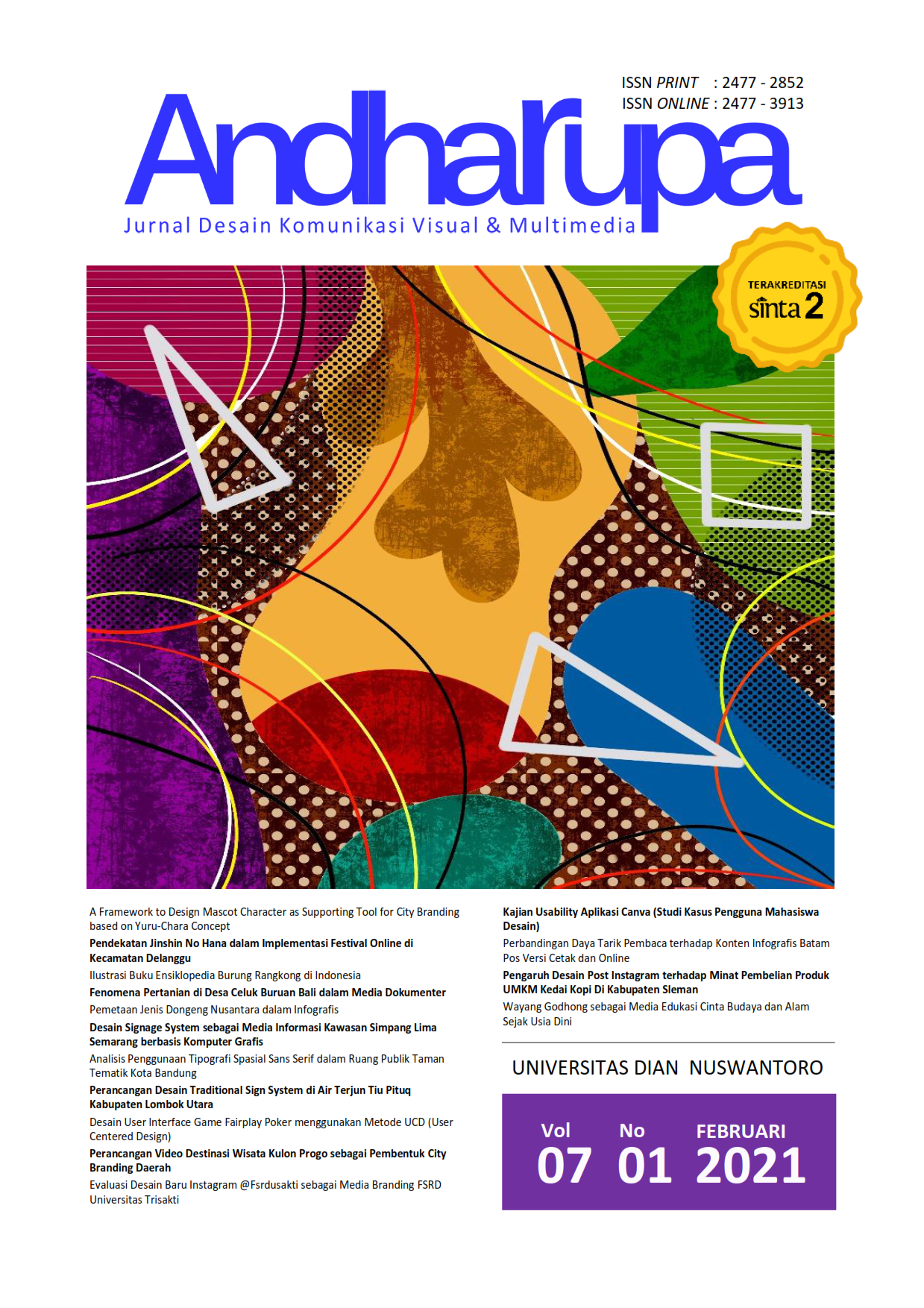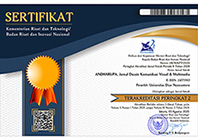PENDEKATAN JINSHIN NO HANA DALAM IMPLEMENTASI FESTIVAL ONLINE DI KECAMATAN DELANGGU
DOI:
https://doi.org/10.33633/andharupa.v7i01.4166Abstract
AbstrakKecamatan Delanggu adalah salah satu area di Kabupaten Klaten yang memiliki popularitas secara nasional dalam hal pertanian padi. Namun sangat disayangkan saat ini kekayaan yang terbangun dari kegiatan pertanian padi seperti budaya, alam dan elemen lainnya makin terkikis dengan arus perkembangan zaman. Oleh karena itu pendekatan edukasi perlu dilakukan kepada masyarakat lokal agar kembali memahami potensi yang mereka miliki dan menjadikannya elemen pembangun masyarakat yang berkelanjutan. Festival merupakan salah satu wadah yang bisa memberikan edutainment bagi masyarakat lokal. Melalui pendekatan Jinshin no Hana, festival dikembangkan dengan menekankan masyarakat lokal sebagai “pemeran utamanya”. Dalam implementasinya pendekatan ini dilakukan dengan metode analisa “treasures mapping”, stakeholders, brainstorming ide dan pemeringkatan melalui pairwise method, dan realisasi. Dalam implementasinya, kondisi pandemik membuat pendekatan diprioritaskan melalui online dan penyelenggaraannya secara terbatas di lapangan. Kegiatan yang dilakukan dalam festival ini ada 6 kategori, yaitu preservasi, perbaikan lingkungan, kesenian, publikasi UKM, permainan berbasis potensi lokal, dan workshop kerajinan jerami padi. Kata Kunci: desa, festival, komunitas, online AbstractDelanggu District is one area in Klaten Regency that has national popularity in the rice farming sector. Unfortunately, in modern days, the intangible wealth developed from traditional rice farming activities such as culture, nature, and other elements are gradually disappeared. Therefore through educational approaches, it is essential to re-introduce the local community to increase their awareness of the local potential and create it as an element of sustainable community development. Festival is one of the media that can provide an edutainment approach for the local community. Through the use of the Jinshin no Hana method, the festival was developed by emphasizing the local community as the “main actor”. In its implementation, this method is performed through treasure mapping analysis, stakeholders analysis, idea brainstorming, and ranking via the pairwise method and implementation. In this pandemic situation, the realization was prioritized by an online and limited person in field implementation. Activities performed in this festival divided into 6, (1) preservations, (2) environmental improvement, (3) art performances, (4) SME’s publication, (5) games based on natural materials development, and (6) rice straw crafts workshops. Keywords: community, festival, online, villageReferences
Biro Pusat Statistik Kabupaten Klaten. (2018). Luas Panen, Produksi, dan Produktivitas Padi menurut Kecamatan (Ha), 2018. URL: https://klatenkab.bps.go.id/statictable/2015/09/17/149/luas-panen-rata-rata- produksi-produksi-padi-sawah-dan-padi-gogo-menurut-kecamatan-di-kabupaten- klaten-tahun-2014.html [Diakses pada 1 Oktober 2020]
Kondo, Y., Nagase, K., Sato, T., Enari, K. (2003). The Design of an Ecofish; A Handmade Graywater Purification Tool as a Circulation Type Resource. The Journal of the Asian Design International Conference, Vol. 1
Purwandaru, P., Wei, F.T., Ueda, A. (2019). The Rice Straw Organization in Japan: Preservation and Development Methods of Japanese Rice Straw Culture. Convash 2019, Surakarta.
Purwandaru, P., Wisesa, T.P., Darajat, T.M. (2018). The Indigenous-Led Regional Development in Delanggu and Juwiring Districts of Indonesia through the Design Approach of “Flowering of the Total Person”. Idealogy journal special issue AICAD18, pp. 215-224.
Suzuki, N., Miyazaki, K. (2008). Flowering of the Total Person: A Practival Design Philosophy for Indigenous-Led Regional Development. Bulletin of JSSD, Vol. 55 No.1, pp.37-46.
Sujiono, B. (2007). Metode Pengembangan Fisik. Edisi Revisi. Jakarta: Universitas Terbuka.
Tabrani, P. (2012). Bahasa Rupa. Cetakan ke-3 dengan revisian. Proses Kreasi Apresiasi Belajar. Bandung: Kelir.
Ueda, A., Ooga, S. (2009). The Culture of “Mottainai” seen as Symbiosis Between Japan’s Ceramic-Producing Regions and the Natural Environment. Bulletin of JSSD, Vol. 57 No.1, pp.65-74.
Downloads
Published
Issue
Section
License
Copyright (c) 2021 ANDHARUPA: Jurnal Desain Komunikasi Visual & Multimedia

This work is licensed under a Creative Commons Attribution 4.0 International License.
Authors who publish with this journal agree to the following terms:
- Authors retain copyright and grant the journal right of first publication with the work simultaneously licensed under a Creative Commons Attribution License that allows others to share the work with an acknowledgment of the work's authorship and initial publication in this journal.
- Authors are able to enter into separate, additional contractual arrangements for the non-exclusive distribution of the journal's published version of the work (e.g., post it to an institutional repository or publish it in a book), with an acknowledgment of its initial publication in this journal.
- Authors are permitted and encouraged to post their work online (e.g., in institutional repositories or on their website) prior to and during the submission process, as it can lead to productive exchanges, as well as earlier and greater citation of published work (See The Effect of Open Access).















